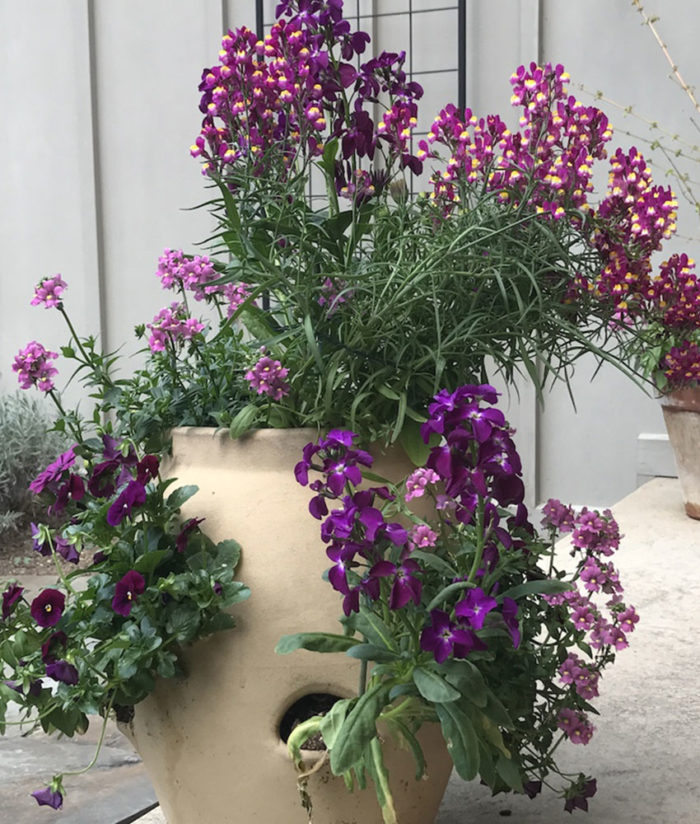
Plant some early color outdoors. Brighten up the early-season landscape with plants that can withstand some chilly weather. As the foliage of spring-blooming bulbs begins to emerge, add to the scenery with complementary bed or container plantings of annuals, many of which actually perform better under cooler conditions. Some may even hold on through the hotter months even if they are not the stars of the summer garden. They may come back into their own with the arrival of cooler temperatures in the fall with some appropriate maintenance. These annuals prove themselves to be good values when a little bit of trimming results in fresh growth and renewed flowering later on.
A few annual choices for early color
Tried and true
|
Don’t forget about
|
Attractive foliage
|

Plant bareroot trees and shrubs. As the month progresses and as soil moisture levels allow, plant woodies and bareroot plants before they leaf out. Less common varieties may more easily be found via mail-order or online sources, but weight is a major factor in shipping costs. When planting, bareroot plants will establish more readily after planting in native soils if sited properly. The root flare and even some of the horizontal roots should be visible at or above the soil grade after installation. Provide extra care to the plant during the first year or so, including proper watering, staking, and protection from damage and weather extremes.

Cut back and divide grasses. Note which grasses in the garden have retained their ornamental appeal through the winter and into early spring, and focus first on cutting back the ones that are broken, flattened, or lying over instead of growing upright. However, wait until grasses are actively growing again before dividing them—the need for which becomes obvious when the center of the plant has died out, resulting in new growth occurring in a “donut” or ring. You don’t want to have accidentally planted a transplant of dead grass. Make several slices with a sharp spade to form a few pieces before digging out these new starts.

Start growing summer-blooming bulbs. Get a head start on summer by potting up and growing summer-blooming bulbs and tubers. These will require some warmth (and light once they sprout) to begin growing well, so plan accordingly by proper indoor siting in bright, warm areas of the home. Also consider using growing lights or heat mats. An important step when moving outside any plant that has spent time inside the home or greenhouse is acclimation. When weather permits, allow these young sprouts to adjust to fluctuations in temperature, light, and moisture by slowly increasing their exposure to these new conditions over a period of a week or two. Some favorite summer-blooming bulbs include:
- Canna (Canna spp. and cvs., Zones 8–12)
- Elephant’s ear (Colocasia spp. and cvs., Zones 8–12)
- Pineapple lily (Eucomis comosa and cvs., Zones 8–12)
- Caladium (Caladium spp. and cvs., Zones 9–12)

Take in the ephemerals before it’s too late. Take a trip to a woodland or park to enjoy those native species that come up early and last a short time. The beginning of spring is when many of them are in their prime, and at times when conditions are not conducive to working in your own garden, get out into natural areas where you might find some of these little charmers. Favorites include:
- Bloodroot (Sanguinaria canadensis, Zones 3–8)
- Dutchman’s breeches (Dicentra cucullaria, Zones 3–7)
- Spring beauty (Claytonia virginica, Zones 3–8)
- Toothwort (Cardamine spp. and cvs., Zones 3–8)
—Jim Kincannon is a graduate of the School of Professional Horticulture at The New York Botanical Garden where he also earned a certificate in landscape design. He is a Master Gardener and was a horticulturist at Newfields in Indianapolis where he now volunteers.
Fine Gardening Recommended Products

Black and Decker 22-inch Cordless Hedge Trimmer

DeWalt Variable-Speed Cordless Reciprocating Saw with 6-Piece Saw Blade Set

Scotts Cordless Grass-Shear/Shrub-Trimmer Combo


















Comments
Log in or create an account to post a comment.
Sign up Log in